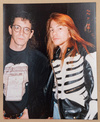2021.08.31 - The First 50 Gigs - Episode 2: Welcome to the Jungle (Part 1) Ft. Laurie Jacobson
Page 1 of 1
 2021.08.31 - The First 50 Gigs - Episode 2: Welcome to the Jungle (Part 1) Ft. Laurie Jacobson
2021.08.31 - The First 50 Gigs - Episode 2: Welcome to the Jungle (Part 1) Ft. Laurie Jacobson
“Do you know where you are? You’re in the Jungle baby!” In Episode 2 of the First 50 Gigs, we’re taking you back…all the way back to the origin of the Sunset Strip and answer Axl’s eternal question with Hollywood historian Laurie Jacobson, author of Dishing Hollywood: The Real Scope on Tinseltown’s Most Notorious Scandals
In this episode you’ll:
• Relive the scandalous history that gave rise to the Sunset Strip and how it became a throughway for Hollywood elite to commute from Beverly Hills to Hollywood.
• See the rise of legendary nightclubs on the Strip that showcased the biggest stars of the 20s, 30s, 40’s and 50’s.
• Witness the eventual decline of the Sunset Strip when a new “strip” took its place, Las Vegas, and learn how a new generation of clubs rose from the ashes of Hollywood to birth a new movement in music with the electrification of rock n’ roll.
Subscribe to our Patreon Site to see the video version of this episode and access the deep archive of historical photographs we used to illustrate this story: https://www.patreon.com/first50gigs_gnr
In this episode you’ll:
• Relive the scandalous history that gave rise to the Sunset Strip and how it became a throughway for Hollywood elite to commute from Beverly Hills to Hollywood.
• See the rise of legendary nightclubs on the Strip that showcased the biggest stars of the 20s, 30s, 40’s and 50’s.
• Witness the eventual decline of the Sunset Strip when a new “strip” took its place, Las Vegas, and learn how a new generation of clubs rose from the ashes of Hollywood to birth a new movement in music with the electrification of rock n’ roll.
Subscribe to our Patreon Site to see the video version of this episode and access the deep archive of historical photographs we used to illustrate this story: https://www.patreon.com/first50gigs_gnr

Blackstar- ADMIN
- Posts : 13787
Plectra : 90377
Reputation : 101
Join date : 2018-03-17
 Re: 2021.08.31 - The First 50 Gigs - Episode 2: Welcome to the Jungle (Part 1) Ft. Laurie Jacobson
Re: 2021.08.31 - The First 50 Gigs - Episode 2: Welcome to the Jungle (Part 1) Ft. Laurie Jacobson
Video snippet:

Blackstar- ADMIN
- Posts : 13787
Plectra : 90377
Reputation : 101
Join date : 2018-03-17
 Similar topics
Similar topics» 2021.09.14 - The First 50 Gigs - Episode 3: Welcome to the Jungle (Part 2) Ft. Domenic Priore
» 2021.12.18 - The First 50 Gigs - Episode 6: First 50 Gigs Mid-Season Recap
» 2021.07.31 - The First 50 Gigs - Episode 0: Series Introduction (Marc Canter)
» 2021.08.15 - The First 50 Gigs - Episode 1: Slash's Garage Bands Ft. Adam Greenberg
» 2021.10.12 - The First 50 Gigs - Episode 5: Bassist Steve Darrow talks about his time in the New Hollywood Rose
» 2021.12.18 - The First 50 Gigs - Episode 6: First 50 Gigs Mid-Season Recap
» 2021.07.31 - The First 50 Gigs - Episode 0: Series Introduction (Marc Canter)
» 2021.08.15 - The First 50 Gigs - Episode 1: Slash's Garage Bands Ft. Adam Greenberg
» 2021.10.12 - The First 50 Gigs - Episode 5: Bassist Steve Darrow talks about his time in the New Hollywood Rose
Page 1 of 1
Permissions in this forum:
You cannot reply to topics in this forum|
|
|

